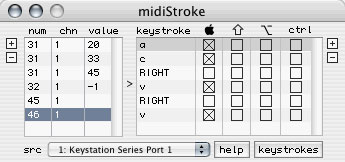TranzPort Quote
“I just got TRANZPORT out of the box and am already up and running! As an artist who writes and records at odd hours (thus without an engineer) this piece is a dream for my studio! Many thanks.”
Tony Vincent (www.tonyvincent.com)
Quick Facts
- Wireless DAW control: operate your computer-based digital audio workstation from anywhere in your studio
- Compatible with Mac® and Windows®
- Supports Pro Tools®, Logic®, Cubase®, Digital Performer®, Sonar™ and other DAW software applications
- Two-way interface: get timecode position, track name/number, track volume, pan settings and more via backlit LCD display and LED indicators
- Uses high-frequency RF technology: no wires or line-of-sight required, and no added interference
- Dedicated buttons for often-used functions, including transport controls, marker/locate buttons, track control (level, pan, solo, mute, record arm) and more
- Operates on AA batteries
- Small, lightweight design
- Footswitch input
- Microphone stand mount, custom padded carrying bag, and standard footswitch are available from the on-line store
TranzPort and midiStroke 1.0 by Charlie Roberts
MidiStroke is a simple to use Mac based application (OS 10.3 and higher) that converts incoming MIDI notes, and CC or Program Change numbers into standard keystrokes, or keystroke combinations. It can be used with the TranzPort to provide basic control over any program that supports keyboard commands such as audio/video editors, games, and many other applications that may not otherwise support external controllers. Because this type of application uses only one-way communication no display or LED feedback is available, however it can provide very useful remote control of your software nonetheless.
The installer can be downloaded as a 68kb freeware file here. Simply copy the application file to your desktop or Applications folder and it is ready to go.

To use midiStroke open the application and select TranzPort from the list of available midi ports under the ësrcí pull-down menu at the bottom. Clicking on the ë+í symbol on the upper-left creates a new line in the table of triggers on the left. Double-click on the default number value that appears there and enter the midi number, cc, or program change number that you want to use. If there is a specific channel number, or cc value that you want to associate with the trigger you can add those as well.
On the right you will define the keystroke response to your midi message along with any modifier keys that you want to attach to it. Special keys like Space, Tab, F-keys, etc can be typed in. A list of the usable special keys is displayed by clicking on the ìkeystrokesî tab at the bottom-right.
More detailed programming instructions are available by clicking the ìhelpî button however this small utility is very easy to learn. The 1.0 version of midiStroke does not have the ability to save multiple instruction sets, but the current set is saved when the application is closed.
MidiStroke uses midi messages expressed as standard decimal numbers instead of the hexadecimal values published in the TranzPort Native mode documentation. Below is a list of the midi notes and values TranzPort sends expressed in decimal values to help make programming midiStroke easier. For all buttons the value at press is 127, release is 0. The data wheel (#60) uses a value of 1 to increase, and 65 to decrease.
| Function | ††††Midi note |
|---|---|
| REW | ††††91 |
| FFWD | ††††92 |
| STOP | ††††93 |
| PLAY | ††††94 |
| RECORD | ††††5 |
| <TRACK | ††††48 |
| TRACK> | ††††49 |
| REC (arm) | ††††0 |
| MUTE | ††††16 |
| SOLO | ††††8 |
| IN | ††††87 |
| OUT | ††††88 |
| PUNCH | ††††120 |
| LOOP | ††††86 |
| PREV | ††††84 |
| ADD | ††††82 |
| NEXT | ††††85 |
| UNDO | ††††76 |
| SHIFT | ††††121 |
| FOOT SW | ††††103 |
| WHEEL | ††††60 |
We encourage visitors to our user forums to post their comments and questions. Other users often have useful ideas and experiences to share, and we monitor the posts to provide additional input.
Below are other TranzPort related links that may be useful:
Copyright © 2025 Frontier Design Group







